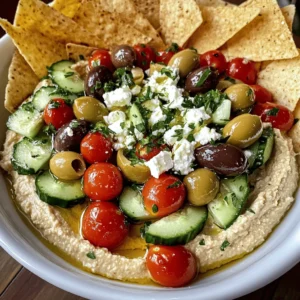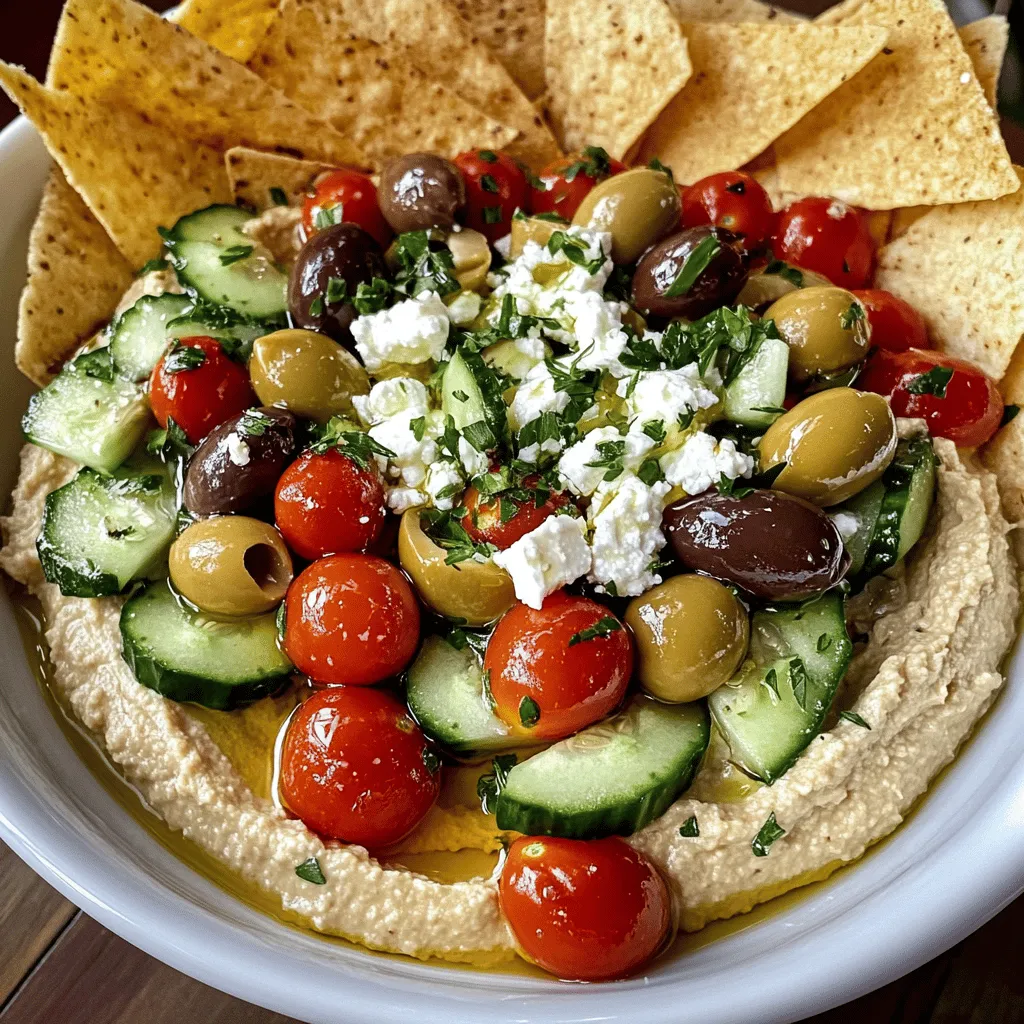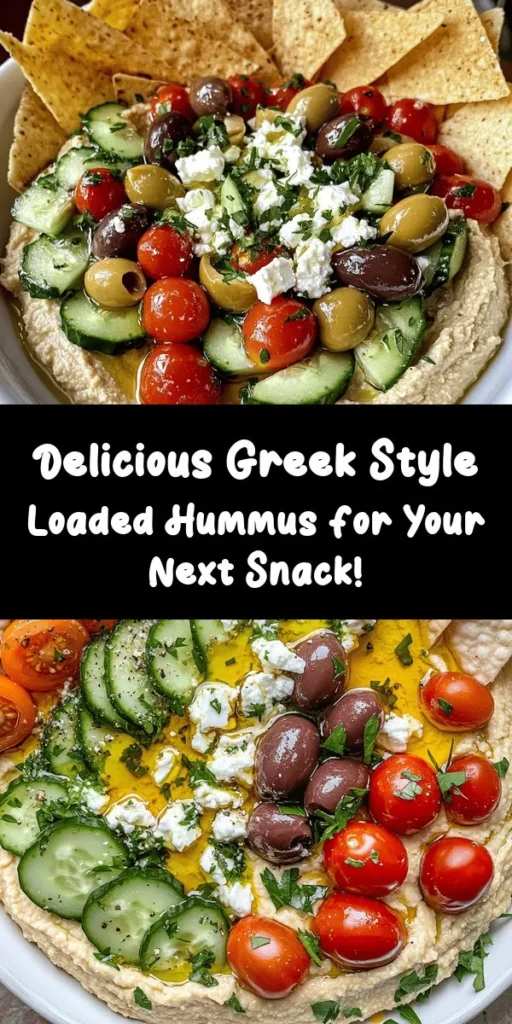Introduction
Greek cuisine is a vibrant tapestry woven from the rich history and diverse landscapes of Greece. Renowned for its emphasis on fresh, high-quality ingredients, Greek cooking celebrates the flavors of the Mediterranean, combining vegetables, grains, fish, and meats in colorful, nutritious dishes. Among the many culinary treasures of this region, hummus stands out as a beloved staple, adored not only for its creamy texture and savory taste but also for its adaptability across various meals and occasions.
Hummus, a traditional dip made primarily from chickpeas, has become integral to Mediterranean diets and is now enjoyed around the globe. Its popularity has surged in recent years, with countless variations emerging to cater to different tastes and dietary preferences. Enter the Greek Style Loaded Hummus—a delightful fusion that brings together classic hummus elements with a distinctly Greek flair. Topped with fresh ingredients such as cherry tomatoes, Kalamata olives, and crumbled feta cheese, this dish is the perfect blend of traditional and modern flavors, making it an enticing choice for any gathering.
Versatile and easy to prepare, Greek Style Loaded Hummus is perfect as an appetizer, a healthy snack, or even a light meal option. Whether you’re hosting a dinner party or simply looking for a nutritious option to enjoy at home, this loaded hummus recipe is bound to impress your guests and tantalize your taste buds.
Understanding Hummus
To truly appreciate Greek Style Loaded Hummus, it’s essential to delve into hummus’s rich history and its significance in both Middle Eastern and Greek cultures. Hummus, which means “chickpea” in Arabic, is believed to have originated in the Middle East, with its presence documented in various ancient texts. Over the centuries, this humble dip has transcended borders, evolving into a dish embraced by many cultures, including Greece.
The nutritional benefits of hummus are as compelling as its history. At its core, hummus is made from chickpeas, which are a fantastic source of plant-based protein and dietary fiber. This combination not only helps keep you satiated but also supports digestive health. The primary ingredients of hummus—tahini, olive oil, lemon juice, and garlic—further enhance its nutritional profile. Tahini, made from ground sesame seeds, is rich in healthy fats, vitamins, and minerals. Olive oil, a staple of Greek cuisine, provides heart-healthy monounsaturated fats and adds depth to the flavor. Lemon juice contributes a bright acidity, while garlic offers a punch of flavor and various health benefits, including anti-inflammatory properties.
In recent years, hummus has taken the culinary world by storm, emerging as a global food trend. Its versatility allows it to be easily adapted into different cuisines, and it is frequently used as a healthier alternative to traditional dips. The rise of hummus reflects a growing interest in plant-based diets and a desire for nutritious, flavorful foods that appeal to a wide range of palates.
Key Ingredients in Greek Style Loaded Hummus
Creating the perfect Greek Style Loaded Hummus requires a thoughtful selection of ingredients, each contributing its unique flavor and texture. Below are the key components that come together to make this dish not only delicious but also nutritious.
Chickpeas
The star of any hummus recipe, chickpeas are packed with protein and fiber, making them an excellent base for a healthy dip. They lend a creamy texture when blended and provide a neutral flavor that allows other ingredients to shine.
Tahini
Tahini is a rich paste made from ground sesame seeds and is a cornerstone of traditional hummus. It adds a nutty flavor and a smooth, creamy consistency to the dip. Additionally, tahini is rich in healthy fats, vitamins B and E, and minerals like calcium and magnesium, making it a nutrient-dense addition.
Olive Oil
Extra virgin olive oil is a staple in Greek cooking, known for its robust flavor and health benefits. It enhances the taste of hummus and contributes beneficial monounsaturated fats, which are linked to heart health. Drizzling olive oil over the finished hummus adds both flavor and an appealing presentation.
Lemon Juice
Freshly squeezed lemon juice brightens the hummus and adds a zesty acidity that balances the richness of the tahini and olive oil. The citrus notes elevate the overall flavor profile, making the dip refreshing and vibrant.
Garlic
Garlic is another essential ingredient that brings a bold flavor to hummus. It adds depth and complexity while offering numerous health benefits, such as antimicrobial properties and potential cardiovascular advantages.
Ground Cumin
Ground cumin introduces warmth and depth to the hummus, enhancing its flavor with a slightly earthy and nutty taste. This spice is commonly used in Mediterranean and Middle Eastern cuisines, making it a fitting addition to our Greek-inspired dish.
Greek Yogurt
To elevate the creaminess of the hummus, Greek yogurt is incorporated into the recipe. Not only does it add a luscious texture, but it also boosts the protein content, making the hummus even more satisfying.
Fresh Toppings: Cherry Tomatoes, Cucumber, Kalamata Olives, Red Onion, Feta Cheese
The toppings are what truly make this hummus “loaded.” Fresh, diced cherry tomatoes and cucumber contribute crunch and brightness, while Kalamata olives add a salty, briny flavor that complements the dip beautifully. Finely chopped red onions lend a sharp bite, and crumbled feta cheese introduces a creamy, tangy element that is synonymous with Greek cuisine.
Fresh Herbs for Garnish
Finally, garnishing the hummus with fresh herbs such as parsley or dill not only enhances its visual appeal but also adds a burst of flavor. Herbs are a quintessential component of Greek dishes, and they serve to elevate this loaded hummus to new heights.
Step-by-Step Instructions for Preparing Greek Style Loaded Hummus
Now that we’ve explored the delicious components that make up Greek Style Loaded Hummus, it’s time to roll up our sleeves and start preparing this delectable dish. Follow these step-by-step instructions to create a hummus that is sure to impress.
Preparing the Hummus Base
1. Gather Your Ingredients: Before you begin, make sure you have all your ingredients ready. You’ll need canned or cooked chickpeas, tahini, olive oil, lemon juice, garlic, ground cumin, and Greek yogurt.
2. Blend the Chickpeas: If you’re using canned chickpeas, drain and rinse them thoroughly under cold water. This will help remove excess sodium and improve the flavor. Add the chickpeas to a food processor.
3. Add the Flavorings: To the food processor, add the tahini, a generous pour of olive oil, freshly squeezed lemon juice, minced garlic, and ground cumin. These ingredients will form the flavorful base of your hummus.
4. Process Until Smooth: Pulse the food processor until the mixture is well combined and smooth. Scrape down the sides as needed to ensure everything is evenly blended.
5. Adjust Consistency: Depending on your preference, you may want to adjust the consistency of the hummus. If it feels too thick, gradually add cold water, one tablespoon at a time, while processing until you reach your desired creaminess.
6. Incorporate Greek Yogurt: Once your hummus base is smooth, add the Greek yogurt and blend again until fully incorporated. This will give your hummus an extra creamy texture and boost its nutritional value.
7. Taste and Adjust Seasoning: Before serving, taste the hummus and adjust the seasoning as needed. You can add more lemon juice for acidity, salt for flavor, or garlic for an extra kick.
By following these steps, you’ll have a delicious, creamy hummus base ready for topping. Next, we’ll explore how to create the yogurt layer and assemble the Greek Style Loaded Hummus, ensuring that every element shines in this vibrant dish.

How to Mix Greek Yogurt with Olive Oil for a Creamy Topping
To create a delightful creamy topping for your Greek Style Loaded Hummus, combining Greek yogurt with olive oil is a fantastic choice. This mixture not only adds a rich texture but also enhances the flavor profile of the dish. Begin with approximately one cup of full-fat Greek yogurt. The creaminess of the yogurt is crucial for an indulgent topping that complements the hummus beneath.
Next, add about two tablespoons of high-quality extra virgin olive oil to the yogurt. This addition will not only elevate the creaminess but also infuse the topping with a fruity and peppery note characteristic of good olive oil. Use a whisk or a fork to mix the two ingredients until they are well combined. You should achieve a smooth, velvety texture that is easy to spread over the hummus. For an extra layer of flavor, consider adding a pinch of sea salt and a squeeze of fresh lemon juice to brighten the mixture.
Assembling the Loaded Hummus
Now that your creamy topping is prepared, it’s time to assemble your Greek Style Loaded Hummus. Start with a generous layer of your homemade hummus spread on a serving platter or shallow bowl. Using the back of a spoon, create a slight well in the center of the hummus. This well will hold your creamy yogurt-olive oil mixture, so it’s essential to make it deep enough to contain the topping without spilling over.
Next, take the yogurt-oil mixture and spoon it delicately into the well you’ve created. Spread it evenly, leaving some space around the edges for the toppings. Now comes the fun part: layering your toppings! Begin with diced cucumbers, cherry tomatoes, and Kalamata olives. These ingredients not only add vibrant colors but also contribute refreshing flavors and textures.
Guidance on Layering the Toppings for Visual Appeal and Flavor Balance
When layering the toppings on your Greek Style Loaded Hummus, consider both aesthetics and flavor balance. Start with the cucumbers, placing them evenly around the yogurt topping. Their crispness contrasts beautifully with the creaminess of the yogurt and hummus.
Next, add a handful of halved cherry tomatoes. Their juicy sweetness complements the savory notes of the hummus and olives. Scatter Kalamata olives throughout for a briny punch, which enhances the Mediterranean vibe of the dish. For added crunch and flavor, sprinkle some diced bell peppers and red onion over the top.
Finally, you can garnish with a sprinkle of crumbled feta cheese if desired, adding a creamy, salty element that ties all the flavors together. Remember to alternate colors and textures to create a visually appealing dish that beckons to be enjoyed.
Final Touches
To finish your Greek Style Loaded Hummus, drizzle a little extra virgin olive oil over the top, allowing it to cascade over the toppings. This will not only enhance the visual appeal but also deepen the flavor. For a vibrant touch, add freshly chopped parsley or dill as a garnish. The herbs add freshness and a pop of color that makes the dish inviting.
If you want to elevate the dish further, consider adding a sprinkle of sumac, a tangy and slightly citrusy spice that is common in Mediterranean cooking. It adds a unique flavor that complements the other ingredients beautifully.
Serving Suggestions
Greek Style Loaded Hummus is incredibly versatile and can be enjoyed in a variety of ways.
1. Pairing with Pita Chips or Fresh Pita Bread: Serve your hummus with crispy pita chips or warm, fluffy pita bread. The contrast of textures makes for a delightful snacking experience. You can even cut fresh pita into triangles and lightly toast them for an extra crunch.
2. Serving Alongside Fresh Vegetables for a Healthy Platter: Create a colorful veggie platter with an assortment of crunchy vegetables such as carrots, bell peppers, cucumbers, and radishes. This not only adds a healthy dimension but also provides a variety of flavors that pair well with the rich hummus.
3. Creative Serving Styles for Gatherings and Parties: When entertaining, consider serving your loaded hummus in individual portions. Use small bowls or cups to create individual servings, making it easy for guests to enjoy without the mess. You could also transform the dish into a mezze platter, incorporating other Mediterranean dishes like stuffed grape leaves, tzatziki, and tabbouleh for a feast that transports your guests to the shores of Greece.
Nutritional Information
When enjoying Greek Style Loaded Hummus, you can feel good about the nutritional benefits it provides.
– Breakdown of Nutritional Values Per Serving: A standard serving of this loaded hummus (approximately 1/2 cup) is typically around 200-250 calories, depending on the specific ingredients used.
– Discussion of Health Benefits Associated with the Ingredients: Hummus is primarily made from chickpeas, which are rich in protein and fiber, promoting feelings of fullness and aiding in digestion. Olive oil contributes healthy monounsaturated fats that are beneficial for heart health. Greek yogurt adds protein and probiotics, which are excellent for gut health. Fresh vegetables not only add flavor but are also low in calories and high in vitamins.
– Caloric Content and Dietary Considerations: This recipe is naturally vegan if you omit the feta cheese and can easily be made gluten-free by ensuring you use gluten-free pita or chips. The hummus itself is dairy-free, making it suitable for those with lactose intolerance.
Variations and Customizations
One of the best aspects of Greek Style Loaded Hummus is its versatility. Here are some suggestions for ingredient swaps or additions to personalize your dish:
– Different Toppings: Explore different toppings like roasted red peppers, artichokes, or creamy avocado. These ingredients can add depth and richness to your loaded hummus.
– Spicing It Up: If you like your hummus with a bit of heat, consider adding jalapeños or a sprinkle of smoked paprika. These spices can add an exciting kick and elevate the flavor profile.
– Personalizing the Hummus Base: You can also customize the hummus base itself by adding roasted garlic for a sweeter, more mellow flavor or fresh herbs like basil or cilantro for a herbal twist. Experimenting with spices such as cumin or coriander can also yield delicious results.
Cultural Significance of Hummus in Greek Cuisine
Hummus holds an important place in Greek cuisine, often served as part of a mezze platter, which includes a variety of small dishes meant for sharing. This communal eating style reflects the Greek culture’s emphasis on togetherness and hospitality. Sharing a meal, especially one that includes hummus, fosters connections and allows for the enjoyment of various flavors in one sitting.
In traditional Greek gatherings and celebrations, hummus is often featured alongside other favorite dishes. It serves not just as a dip but as a conversation starter, allowing guests to share their thoughts on the flavors and textures, creating a warm and inviting atmosphere.
Conclusion
Greek Style Loaded Hummus is a celebration of Mediterranean flavors, combining creamy textures with vibrant toppings that make it a feast for both the eyes and palate. This dish is not only delicious but also versatile, allowing for a variety of serving styles and ingredient customizations that suit any occasion.
Embrace the opportunity to explore these Mediterranean flavors, and consider sharing the experience with family and friends. The importance of fresh, wholesome ingredients cannot be overstated, as they are the foundation of satisfying and nourishing meals. So gather your ingredients, get creative, and enjoy the delightful journey of making and sharing Greek Style Loaded Hummus.



